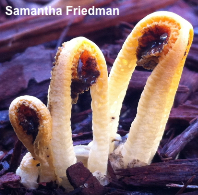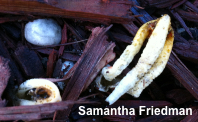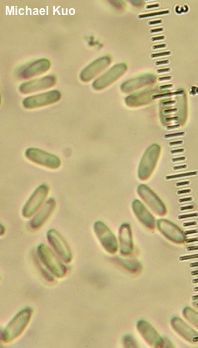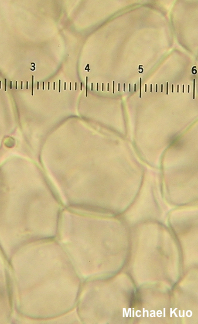| Major Groups > Stinkhorns > Laternea triscapa |

|
Laternea triscapa [ Basidiomycota > Agaricomycetes > Phallales > Clathraceae > Laternea . . . ] by Michael Kuo On casual inspection this tropical stinkhorn looks like the better-known and more widely distributed Clathrus columnatus, but a closer look reveals important differences. Whereas the stinky, fly-attracting spore slime of Clathrus columnatus is produced on the inner edges of its arms, near the top of the stinkhorn, Laternea triscapa features a cross-bar, suspended under the arch of the arms, forming a special structure to produce the spore slime. Thus Laternea triscapa is actually more similar to its close relative, Laternea pusilla, which differs by having crested, fringed arms. The collection illustrated and described here is much smaller than typical specimens of Laternea triscapa, which is described as up to 70 mm high by Dring (1980), 30–50 mm high by Reid (1977), or "aproximadamente 5 cm. de altura" by López, Martínez, and García (1981). A very tiny species, Laternea dringii, which was described from Mexico, may or may not be distinct from Laternea triscapa (see the extended discussion below); if it is distinct, it might be a better match for the collection featured here. Thanks to Samantha Friedman for documenting, collecting, and preserving Laternea triscapa for study; her collection is deposited in The Herbarium of Michael Kuo. Description: Ecology: Saprobic; growing gregariously, often near woody debris, in lawns, gardens, cultivated soil, and so on—and in tropical forests, especially in disturbed ground areas and where forest litter has accumulated; appearing year-round; originally described from Tortuga (Haiti); distributed in the Caribbean, Central America, South America, and North America from Mexico to Florida. The illustrated and described collection is from Florida. Immature Fruiting Body: A whitish to grayish "egg" 1–1.5 cm high; when sliced revealing the stinkhorn-to-be encased in a gelatinous substance. Mature Fruiting Body: 19–32 mm high; consisting of 2–3 columnar arms connected at the apex and free at the base, with a transverse branch (a glebifer) connecting the arms near the apex. Arms: 3–6 mm thick; somewhat flattened on the outer side; convex on the inner side; soft; dry; spongy but with an imperforate surface; wrinkled; orange to pale orange apically, but nearly whitish basally. Transverse branch hanging below the arch formed by the arms, forming a glebifer; ellipsoid in outline; 2–5 mm thick; rugged; spongy; covered with spore slime. Volva: Sac-like, encasing the base of the fruiting body; whitish with a grayish edge. Base attached to numerous white rhizomorphs. Spore Slime: Dark brown; restricted to the glebifer; malodorous. Microscopic Features: Spores 4–5.5 x 1.5–2 µm; cylindric; smooth; hyaline in KOH; inamyloid. Sphaerocysts of the branch context 11–25 µm across; subglobose to irregular; smooth; walls 0.5–1 µm thick; hyaline in KOH. Volval hyphae 2–4 µm wide; smooth; thin-walled; hyaline in KOH; clamp connections not found. REFERENCES: P. J. F. Turpin, 1822. (Reid, 1977; Dring, 1980; López et al., 1981; López et al., 1982; Sáenz & Nassar, 1982; Sáenz et al., 1983; Calonge et al., 2004; Baseia et al., 2006; Cabral et al., 2012; Magnano et al., 2013; Trierveiler-Pereira et al., 2013; Trierveiler-Pereira et al., 2014; Calonge et al., 2015.) Herb. Kuo 10031201. Laternea dringii was described by López, Martínez, and García (1981) on the basis of collections made in Veracruz, Mexico. The authors listed a height of 13–15 mm for the mature stinkhorns. Calonge et al. (2004) reduced Laternea dringii to synonymy with Laternea triscapa, but other authors (including Sandoval-Leiva et al. 2014 and Magnago et al. 2017) recognize Laternea dringii as distinct based on its morphology. However, an apparent typographical error in the original description forms part of the basis for the distinction; in comments the authors say Laternea dringii "se define por presentar un brazo transversal que une las columnas en el ápice," but continue that their material can be separated from Laternea triscapa and Laternea pusilla, “como se puede ver en la Tabla 2, por la ausencia del brazo transversal” (my emphasis)—and the subsequent table does not include a row presenting data for the presence of transverse arms. Instead, Table 2 has a column for "Crestas sobre el borde exterior de las columnas," and this information is missing from the preceding narrative. It appears that the statement about the absence of transverse arms is a typographical error for the absence of fringe-like crests; this explanation renders the conflict between statements and the table comprehensible. Magnago et al. (2017), uncritically citing the typographical error in the original publication, recognize Laternea dringii as distinct partially because it "lacks a transverse column." Resolution of the validity of Laternea dringii will thus depend on study of original DNA sequences from well-documented collections of both Laternea dringii and Laternea triscapa, and careful morphological comparisons. This site contains no information about the edibility or toxicity of mushrooms. |
© MushroomExpert.Com |
|
Cite this page as: Kuo, M. (2021, September). Laternea triscapa. Retrieved from the MushroomExpert.Com Web site: http://www.mushroomexpert.com/laternea_triscapa.html |




